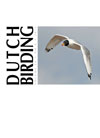Dutch Birding volume 34 (2012) no 6

Caspian Stonechat on Vlieland in October 2012
On 6-20 October 2012, a male Caspian Stonechat Saxicola maurus variegatus stayed on Vlieland, Friesland, the Netherlands. It was identified as Siberian Stonechat S maurus because of its unmarked white rump, large expanse of white on inner wing-coverts, broad pale band on neck-side and black axillaries. It could be identified as subspecies variegatus because it showed c 80% white on the inner web of t3-6. In other subspecies of Siberian Stonechat, the white is less extensive or absent. Other characters consistent with variegatus included the large white rump, contrast between dark axillaries and pale remiges, cold sand-coloured upperparts and broad band on neck-side. White-tailed Stonechat S leucurus could be excluded by tail pattern, which shows the extensive white pattern also on t2. The bird showed multiple wart-like growths on its toes and had mostly pink instead of black legs, probably caused by a virus. The bird could be aged as an adult by its black lore, black-and-white tail pattern (more brownish and buffish in first-winter), narrow white fringes to primary-coverts (broader and more ragged in first-winter), adult-type wing-coverts and blackish remiges.
Variegatus is treated as a subspecies of Siberian Stonechat; together with armenicus, it is geographically isolated from the other subspecies and together these two subspecies are known as Caspian Stonechat. Recent molecular work comparing different stonechat taxa included only four examples of variegatus. The results were ambiguous and indicated that two individuals were closely related to S m maurus and two to S m stejnegeri. More research is needed to clarify the systematic position. Recently, it has been shown that the current nomenclature is incorrect: variegatus was first described in armenicus range; thus, the correct name for armenicus is variegatus. The population formerly known as variegatus should, strictly speaking, be named amaliae or hemprichii but, for practical reasons, such treatment is not followed here. Variegatus breeds west and north of the Caspian Sea and winters mainly in north-eastern Africa. It is a vagrant to Europe, with nine records in north-western Europe and 11 in south-eastern Europe. If accepted, the Vlieland bird constitutes the first record of variegatus for the Netherlands.
Sander Bot, Postbus 41139, 9701 CC Groningen, Nederland
(sanderbot yahoo.co.uk)
yahoo.co.uk)
Nils van Duivendijk, Veluwemeer 82, 3446 JC Woerden, Nederland
(nils.van.duivendijk casema.nl)
casema.nl)
Eddy Nieuwstraten, Mozartstraat 14, 6521 GC Nijmegen, Nederland
(eddynieuws gmail.com)
gmail.com)
Han Zevenhuizen, 's-Gravenhof 20, 2415 CB Nieuwerbrug, Nederland (hanzevenhuizen gmail.com)
gmail.com)
terug






